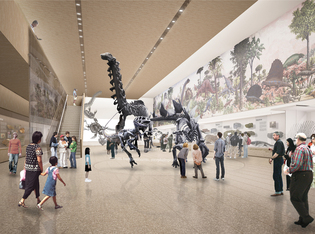 loading
loading
Light & VerityA $30 million overhaul for accuracy’s sakeThe Peabody's dinosaurs are getting a tail-raising.  Courtesy Cooper Joseph StudioView full imageThe dinosaurs that have delighted visitors to the Peabody Museum of Natural History for decades will soon be in line for a long-overdue makeover. The $30 million project, the timing of which is contingent on fund-raising efforts currently under way, is designed around reconstructing, conserving, and correcting the postures of Apatosaurus, Stegosaurus, and other residents of the museum’s Great Hall. The reason, says Peabody director Derek Briggs, is science: “We now know that dinosaurs weren’t slow, lumbering, tail-dragging beasts.” But that’s how scientists saw them when the skeletons were assembled some 80 years ago. Since then, researchers have realized that dinosaurs had more in common with energetic, fast-moving birds than with cold-blooded reptiles. And thanks to popular culture (think Jurassic Park), word has gotten out. “These days, even a six-year-old can tell us what’s wrong with the exhibits,” says Briggs. “So it’s definitely time for a change.” “We’re still going to use the real fossil bones as far as possible—other museums are using plaster casts—so the conservation and correction process is expensive,” says Briggs. But the availability of modern, lightweight materials means that the skeletons can be reassembled without the obtrusive steel armatures that prevail in the Great Hall today. The changes are part of a much larger master plan that calls for a major architectural addition to the museum in the coming years. For now, in addition to getting those dinosaur tails off the ground, plans call for a balcony in the Great Hall to give visitors a new perspective on the skeletons. Briggs envisions a variety of electronic exhibits enabling museum-goers to see how the science has changed and how, for example, Rudolph Zallinger’s iconic 1940s mural might be painted today. The adjacent Hall of Mammals will be upgraded as well. Briggs hopes to complete the project by 2016. “We’ll have to close the Great Hall for a while, but we’ll fill in with temporary exhibits, and the other parts of the museum, which will remain open. It’ll be a challenge, but in the end, it’ll be spectacular.”
The comment period has expired.
|
|